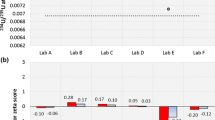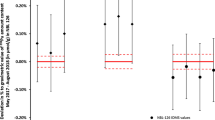Abstract
We present a new analytical method for accurately measuring femtogram amounts of Pu in environmental swipe samples using a high-purity 244Pu spike and multi-collector inductively-coupled-plasma mass spectrometry. The method was validated by comparative measurements of samples that were previously analysed using a 242Pu spike. The 244Pu spike allows direct normalization of all Pu isotopes to both 244Pu and 239Pu, along with online monitoring of PbAr interferences, resulting in highly-sensitive and accurate Pu assay and isotope ratio measurements. Expanded uncertainties were typically < 2.5% for Pu amounts larger than 20 fg, and < 1% for Pu isotope ratios larger than 0.08. Detection thresholds (Lc) were well below 1 fg for all Pu isotopes.






Similar content being viewed by others
Notes
The “242Pu method” has been in use at the IAEA ESL since 2013, and differs from the method described by Eppich et al. [18] in 2019. The published method [18] represented an experimental study for the determination of Pu assay and isotope ratios in swipe samples when using a 242Pu spike. However, that method has not been fully implemented for routine Pu analysis.
References
International Atomic Energy Agency (2016) IAEA Safeguards—Delivering Effective Nuclear Verification for World Peace. https://www.iaea.org/topics/basics-of-iaea-safeguards. Accessed 2 Nov 2020
International Atomic Energy Agency (1970) INFCIRC/140 Treaty on the Non-Proliferation of Nuclear Weapons, Vienna, Austria
International Atomic Energy Agency (1972) INFCIRC/153 (corrected) The structure and content of agreements between the Agency and States required in connection with the Treaty on the Non-Proliferation of Nuclear Weapons, Vienna, Austria
International Atomic Energy Agency (2002) IAEA Safeguards Glossary, 2001 edn., International Nuclear Verification Series No.3, Vienna, Austria
International Atomic Energy Agency (2011) Safeguards Techniques and Equipment, 2011 edn., International Nuclear Verification Series No.1 (Rev.2), Vienna, Austria
Milton MJT, Quinn TJ (2001) Primary methods for the measurement of amount of substance. Metrologia 38:289–296
Bureau International des Poids et Mesures, Consultative Committee for Amount of Substance (CCQM), 5th Meeting (February 1999), https://www.bipm.org/en/committees/cc/ccqm/5-1999. Accessed 23 Nov 2020
Heller A (2017) Plutonium isotope standard enhances international safeguards, In: Research Highlights - S&TR October/November 2017, Lawrence Livermore National Laboratory, USA
International Atomic Energy Agency (2012) Advisory material for the IAEA regulations for the safe transport of radioactive material. https://www-pub.iaea.org/MTCD/publications/PDF/Pub1586web-99435183.pdf. Accessed 29 Jul 2021
Peńkin M, Humphrey M, Kryzhanovsky A, Vyachin V, Iyengar A (2016) Separation of high-purity 244Pu for safeguards applications. J Radioanal Nucl Chem 307:2091–2094
Essex RM, Williams RW, Treinen KC, Hubert A, Humphrey MA, Inglis JD, Kinman WS, Maassen J, Peńkin MV, Steiner RE (2020) A highly-enriched 244Pu reference material for nuclear safeguards and nuclear forensics measurements. J Radioanal Nucl Chem 324:1–14
Certificate of Analysis CRM 131- Plutonium-244 in Nitrate Form (Plutonium Spike Assay and Isotopic Standard) (1987) New Brunswick Laboratory, U.S. Department of Energy, IL, USA
Certified Reference Material IRMM-042a (2017) Certificate of Analysis, European Commission Joint Research Centre, Directorate G, Nuclear Safety and Security, G.2, Standards for Nuclear Safety, Security and Safeguards Unit, Geel, Belgium
Certified Reference Material IRMM-042 (1984) Provisional Certificate, Commission of the European Communities, Joint Research Centre, Geel Establishment, Central Bureau for Nuclear Measurements, Geel, Belgium
Certificate Spike Isotopic Reference Material IRMM-085 (2000) European Commission, Institute for Reference Materials and Measurements, Geel, Belgium
Deron S, Vesnovskii S (1999) Development of technology for high-purity 244Pu production by method of electromagnetic separation. Nucl Instrum Methods Phys Res Sect A 438:20–22
Boulyga S, Konegger-Kappel S, Richter S, Sangély L (2015) Mass spectrometric analysis for nuclear safeguards. J Anal At Spectrom 30:1469–1489
Eppich GR, Mácsik Z, Katona R, Konegger-Kappel S, Stadelmann G, Köpf A, Varga B, Boulyga S (2019) Plutonium assay and isotopic composition measurements in nuclear safeguards samples by inductively coupled plasma mass spectrometry. J Anal At Spectrom 34:1154–1165
Report of attribute values, Pu-244 spike, 244Pu assay and isotopic reference material (2019), LLNL-Mi_757407.
Certificate of analysis CRM 112-A—Uranium (normal) Metal Assay and Isotopic Standard (2010) New Brunswick Laboratory—U.S. Department of Energy, IL, USA
Certified Reference Material IRMM-2025 (2018) Certificate of Analysis, European Commission Joint Research Centre, Directorate G, Nuclear Safety and Security, G.2, Standards for Nuclear Safety, Security and Safeguards Unit, Geel, Belgium
Certificate of Analysis CRM 144—Plutonium 240-242-244 in Nitrate Form (Plutonium Spike Assay and Internal Standard) (1994) New Brunswick Laboratory, U.S. Department of Energy, IL, USA
Isotopic reference material CBNM - IRM -047a (1985) Commission of the European Communities, Joint Research Centre, Central Bureau for Nuclear Measurments, Geel, Belgium
CRM 137- Plutonium Isotopic Standard (2002) In: NBL Certified Reference Materials Catalogue, New Brunswick Laboratory, U.S. Department of Energy, IL, USA
Certificate of Analysis CRM 126-A—Plutonium metal assay and isotopic standard (2004) New Brunswick Laboratory, U.S. Department of Energy, IL, USA
CRM 122- Plutonium Oxide - PuO2 (2002) In: NBL Certified Reference Materials Catalogue, New Brunswick Laboratory, U.S. Department of Energy, IL, USA
Boulyga SF, Koepf A, Konegger-Kappel S, Macsik Z, Stadelmann G (2016) Uranium isotope analysis by MC-ICP-MS in sub-ng sized samples. J Anal At Spectrom 31:2272–2284
Eiden GC, Duffin AM, Liezers M, Ward JD, Robinson JW, Hart GL, Pratt SH, Springer KW, Carman AJ, Duckworth DC (2014) High precision isotopic analysis of actinide bearing materials: performance of a new generation of purpose built actinide multi collector ICPMS instruments (IAEA-CN-218-134). https://www-pub.iaea.org/MTCD/Publications/PDF/SupplementaryMaterials/P1706/Technical_Session_3F.pdf. Accessed 28 May 2016
Richter S, Konegger-Kappel S, Boulyga S, Stadelmann G, Koepf A, Siegmund H (2016) Linearity testing and dead-time determination for MC-ICP-MS ion counters using the IRMM-072 series of uranium isotope reference materials. J Anal At Spectrom 31:1647–1657
Tuttas D, Schwieters JB, Bouman C, Deerberg M, In: Application Note: 30192 new compact discrete dynode multipliers integrated into the thermo scientific TRITON variable multicollector array. https://assets.thermofisher.com/TFS-Assets/CMD/Application-Notes/AN-30192-TIMS-TRITON-Plus-AN30192-EN.pdf. Accessed 19 Dec 2022
Kramida A, Ralchenko, Yu., Reader, J. and NIST ASD Team (2019) NIST Atomic Spectra Database (version 5.7.1). https://physics.nist.gov/asd. Accessed 9 Jul 2020
Mathew KJ, Ottenfeld C, Keller R, Slemmons A (2018) Systematic bias in the 240Pu/239Pu isotopic ratio of plutonium isotopic standard CRM138. J Radioanal Nucl Chem 318:395–400
Taylor RN, Warneke T, Milton JA, Croudace IW, Warwick PE, Nesbitt RW (2001) Plutonium isotope ratio analysis at femtogram to nanogram levels by multicollector ICP-MS. J Anal At Spectrom 16:279–284
Yang L, Tong S, Zhou L, Hu Z, Mester Z, Meija J (2018) A critical review on isotopic fractionation correction methods for accurate isotope amount ratio measurements by MC-ICP-MS. J Anal At Spectrom 33:1849–1861
Meija J, Yang L, Sturgeon R, Mester Z (2009) Mass bias fractionation laws for multi-collector ICPMS: assumptions and their experimental verification. Anal Chem 81:6774–6778
R Core Team (2018) R: a language and environment for statistical computing. R Foundation for Statistical Computing, Vienna, Austria. https://www.R-project.org/.
JCGM 200:2012 International vocabulary of metrology, Basic and general concepts and associated terms (VIM), (2012) 3rd edn. https://www.bipm.org/documents/20126/2071204/JCGM_200_2012.pdf/f0e1ad45-d337-bbeb-53a6-15fe649d0ff1. Accessed 19 Dec 2022
S L R Ellison and A Williams (2012) In: Eurachem/CITAC guide: Quantifying Uncertainty in Analytical Measurement, 3rd edn. https://www.eurachem.org/index.php/publications/guides/quam. Accessed 19 Dec 2022
Currie LA (1968) Limits for qualitative detection and quantitative determination. Appl Radiochem Anal Chem 40:586–593
Morss LR, Edelstein NM, Fuger J (2006) The chemistry of the actinide and transactinide elements, vol 1–5, 3rd edn. Springer, Dordrecht
Pointurier F, Williams RW, LaMont SP, Steiner RE, Bostick DA, Olsen KB, Wogman NA (2013) Round-robins in the area of uranium and plutonium bulk analysis of environmental samples. J Radioanal Nucl Chem 296:599–608
Acknowledgements
We thank Herbert Siegmund, Guillaume Stadelmann and Gary R. Eppich for their support in equipment troubleshooting and for the valuable discussions on the subject of this paper. Zsuzsanna Mácsik is acknowledged for her help in the selection of archived swipe samples for comparison measurements, and for the initial preparation and amount verification of the used 244Pu CRM at the IAEA ESL. Beata Varga is acknowledged for her advice during the validation of this method. Alena Bulyha and Alexander Venzin are acknowledged for developing Visual Basic and R-codes for uncertainty calculations and data evaluation automation. Furthermore, the authors would like to thank Renáta Buják for her review and for providing insightful comments.
Author information
Authors and Affiliations
Corresponding author
Ethics declarations
Conflict of interest
The authors have no relevant financial or non-financial interests to disclose.
Additional information
Publisher's Note
Springer Nature remains neutral with regard to jurisdictional claims in published maps and institutional affiliations.
Supplementary Information
Below is the link to the electronic supplementary material.
Rights and permissions
Springer Nature or its licensor (e.g. a society or other partner) holds exclusive rights to this article under a publishing agreement with the author(s) or other rightsholder(s); author self-archiving of the accepted manuscript version of this article is solely governed by the terms of such publishing agreement and applicable law.
About this article
Cite this article
Konegger-Kappel, S., Koepf, A., Katona, R. et al. A new era of plutonium assay and isotope ratio measurements at ultra-low levels in IAEA safeguards environmental swipe samples by isotope dilution MC-ICP-MS using a 244Pu spike. J Radioanal Nucl Chem 332, 2887–2904 (2023). https://doi.org/10.1007/s10967-023-08880-x
Received:
Accepted:
Published:
Issue Date:
DOI: https://doi.org/10.1007/s10967-023-08880-x




